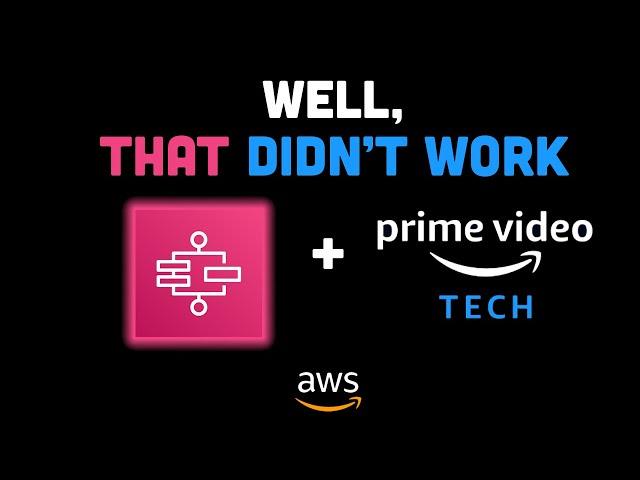
How and Why Prime Video Tech Switched From Serverless to "Monolith"
Комментарии:

Many of the issues are caused by CTOs that forces a specific technology on all of their backend systems, when they should in stead use the right technology and implementation for each of the use cases.
Ответить
Yeah, the redesign is not a monolith. The whole argument is absurd.
Ответить
Cost optimization is a tenant within AWS for its customers. I don't see any problem with AWS using the same cost saving approach with its own services. This doesn't mean serverless is crap, don't use serverless, etc. It means cost savings and only that. AWS analyzed their tech stack and came up with the same performance at less cost. Nothing more to see here... Great explanation!
Ответить
Right on!! Awesome video
Ответить
Senior engineer at Amazon here. I generally dislike comments that may be perceived as negative, but I do believe we are using the wrong terminology here. This service didn’t switch from “serverless to monolith”. They switched from distributed microservices to monolith which isn’t the same thing. In fact, many of the components of the current infrastructure of this service (S3, SNS, CloudWatch, IAM, etc) are serverless. Others are not.
Just like you can have self-hosted microservices, you can also have a monolith built on serverless technologies. E.g: using Fargate on top of ECS. This is a hosted monolith that uses some serverless components.
It’s also important to highlight that the tradeoffs for using these technologies internally are somewhat different from using them externally.
Side note: the description is linking to the wrong article.

I had been waiting for your take and was wondering why it took so long 😁 .Thank you. Excellent
Ответить
Thank you! I've been waiting for this video 🙌🏼
Ответить
Great breakdown. Thank you. Reminded me of Khan Academy. What do you use to draw on the screen like that?
Ответить
I hope they lay off whatever's left of the Amplify team and let that trash heap die.
Ответить
Nevertheless, it is not monolith since it uses separate services for partners’ upload and customer download ;) *nonsense*: it is same as discussing “why Windows is monolith”. Both terms, “monolith” and “serverless”, are not applicable to the platform providing these design patterns out of the box.
Ответить
First, title is a huge click bait.
Second, they still use serverless for several operations.
Third, serverless is not the only way to implement microservices.
Fourth, they turned a solution based on distributed serverless functions into a service, which can perfectly be considered as a microservice itself.

Great video. Really only the 2nd video I've seen that isn't misrepresenting what the article actually says to support some "monoliths are back" or "amazon went back to monoliths" narrative. It was very disappointing seeing some distinguished/notable software developers misrepresenting what actually happened (at the same time, I was also confused if I missed something).
Ответить
Lol, felt like I’m watching khan academy for Aws. Really like the format!
Ответить
Good to know Amazon is no longer spending so much money on Amazon
Ответить
Step function is a bad product. Amazon prime team just chose wrong service and it doesn't mean serverless is bad and monolithic is good in terms of cost.
Ответить
Great video.
I really don't get when people try to force others into trashing completely an approach. I think in the tech world, the right answer is always "it depends". There is always a trade off in every solution. A good architect is the one who find the trade off that is more convenient for that specific customer, in that specific scenario, in that specific use case.

As always, great video.
Thank you.
BTW, what is the tool that you are using for the handwritten note?

Good explanation,
Wise analysis of the case study.
Totally agree with your opinion (even before watching the video).
However, the red color sucks in the black background 😅 (yellowor orange could be better)

Good video, I personally like these architectural deep dives
Firstly, the use of S3 as a malformed in-memory cache confused me when I first read the article. Personally, something like EFS seems like itd be better suited for the job but who knows
Secondly, it seems like they just re-architected as the problem space changed. They realised the solution they had before couldn't handle large amounts of streams and, thus, they rearchitected. The idea that we have to be "team serverless" or "team monolith" always struck me as a misguided argument when it should be "team best-tech-for-the-problem-at-the-moment"

Thanks a lot!
You might want to improve the colors used to write, red is not that clearly visible.

Red colour is not clearly visible
Ответить





![44회 요약 | 파주 택시기사 살인사건 (1) | 교통사고로 시작해 연쇄살인으로 드러난 크리스마스의 악몽 [용감한형사들3] 매주 (금) 밤 8시 40분 본방송 44회 요약 | 파주 택시기사 살인사건 (1) | 교통사고로 시작해 연쇄살인으로 드러난 크리스마스의 악몽 [용감한형사들3] 매주 (금) 밤 8시 40분 본방송](https://ruvideo.cc/img/upload/OFRVRkphRDFCWXE.jpg)

![[이춘근교수방송 1회 복개도로 건설문제] 복개도로는 왜 건설하지 않아야 하나? [이춘근교수방송 1회 복개도로 건설문제] 복개도로는 왜 건설하지 않아야 하나?](https://ruvideo.cc/img/upload/QUVSNWhveFZGRkg.jpg)

















